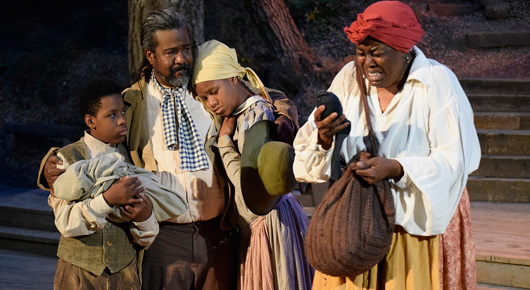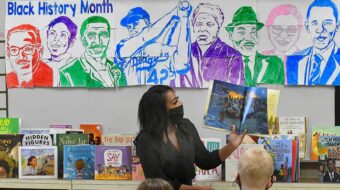
TOPANGA CANYON, Calif. – Will Geer’s Theatricum Botanicum’s (WGBT) production of Tom is artistic director Ellen Geer’s adaptation of Harriet Beecher Stowe’s 1851 abolitionist novel Uncle Tom’s Cabin. Geer, who also directed, added post-Civil War scenes depicting Stowe (Melora Marshall), who is still fretting over slavery. These additional 1886 vignettes enable the playwright to presciently ponder the plight of Blacks after the Reconstruction Era, but also in our own times wherein police and vigilante violence, institutionalized racism, the racist Trump candidacy, and more continue to beset and bedevil African Americans. These Stowe sequences, interwoven into the fabric of the play – which is mostly a dramatization of the original book – also allow Tom to explore feminist issues, particularly the role of women in literature.
Most of Tom, like its literary source, is set in the antebellum South. Many are likely to find this excursion to the land of cotton to be quite disturbing. The systematic cruelty required to maintain and enforce slavery is graphically depicted onstage. Along with whippings there are detestable auctions of humans, breaking up families. (Speaking of which, you might want to leave the kiddies at home. Sensitive souls may be disturbed by the harsh historical realities depicted onstage.)
All human beings yearn to be free and in order to rein this natural liberty-loving tendency in, slave masters like the despicable Simon Legree (Thad Geer) had to constantly use brutal force. The perpetual abuse inherent in a dehumanizing system that reduced flesh and blood thinking and feeling people to mere property is truly revolting (in every sense of the word).
Gerald Rivers is an interesting choice to depict Tom. A mainstay at the Theatricum, Rivers has played Shakespearean and other characters at this Topanga Canyon outpost of Los Angeles beneath the stars. But the dreadlocked Rivers is best known, and rightfully so, for his perfect portrayal of Dr. Martin Luther King, Jr., which he does in an excellent one-man show.
In Stowe’s novel and WGTB’s version, it’s true that Tom declines to become a runaway and is extremely loyal to his more benevolent masters. However, Tom does urge others to flee slavery and ride that underground railroad to freedom. And most importantly, he refuses Legree’s direct order to do something ethically abhorrent to literally save his own skin. In doing so, Tom is arguably defying slavery and committing an act of civil disobedience. One could argue that Tom – with his Christian, turn-the-other-cheek faith and pacifism – is an archetype for Dr. King himself, who, like Tom, was consumed by the racist culture around him.
On the other hand, as Durant Fowler – the actor who played George Harris – pointed out to me at the world premiere’s after party, his character may well be the prototype for Malcolm X. George joins Eliza (Jasmine Gatewood) as they run away with their son toward freedom in Canada (in a canny bit of casting Durant’s real-life son, Angelo Fowler, plays his onstage child). When vigilantes citing the Fugitive Slave Act attempt to apprehend the trio to return the “property” to their “rightful owner,” George opens fire on them. One could make the point that George is also the literary archetype for Jamie Foxx as the title character in Quentin Tarantino’s 2012 film Django Unchained.
And while we’re at, the friendly relationship between the little blonde plantation daughter Eva (Lily Andrew) and Tom was also the prototype for the onscreen pairing of Bill Bojangles Robinson and another young girl, Shirley Temple, in 1935 flicks such as The Little Colonel and The Littlest Rebel. Apparently, in the ’30s, these interracial pairings were deemed acceptable and unthreatening because the age differences between the Black male adult and the white female child excluded sex from the “innocent” equation. (Since Blacks were regarded by racists as being “childlike,” this coupling may have been widely perceived as being between two children.)
Eliza’s fleeing across ice floes on a partially melted river, of course, influenced D.W. Griffith’s shooting of a similar, dramatic icy scene featuring Lillian Gish in the 1920 silent morality play Way Down East.
Tom makes good use of Gospel music and Negro Spirituals – some are performed live, while others are recordings, including some Paul Robeson numbers. As usual, the actors, playing in the hilly wilds of deepest darkest Topanga, make good use of the rustic space in an amphitheater environment. Actors sometimes bolt up and down the aisles, and when Eliza and Harry flee, they are glimpsed above the set per se on the hillside making their way through the forest – the clever theatrical equivalent of a long shot.
Standouts in the cast include Earnestine Phillips in a double role as Tom’s wife Aunt Chloe and Prue (Mammy-like archetypes), a WGTB stalwart equally at home reciting Shakespeare. The brutal slaves Sambo (Rodrick Jean-Charles) and Quimbo (Clarence Powell) are quite chilling as Legree’s enforcers – reminding me of those traitorous “kapos,” Jews who collaborated with the Nazis to oppress their own brethren in the concentration camps.
It’s remarkable, in terms of how art expresses the zeitgeist, that this production premiered almost on the exact 50th anniversary of Stokely Carmichael’s famous 1966 “Black Power” speech. The heartbreaking two-act Tom reminds us that, alas, the problems Stowe exposed and Stokely opposed continue in our own day and age. Racism may be America’s original sin – but unfortunately, it continues today.
Yet it seems appropriate that this version of Uncle Tom’s Cabin is being performed right near the cabin of Woody Guthrie, the people’s troubadour who fought for truth, justice and the progressive way with his guitar – that machine that killed fascists, as Woody said. Onstage, the Stowe of 1886 denies that slavery has really ended and the same could be said of our own time, as this drama reminds us that racial injustice persists.
Tom is playing in repertory through Oct. 1 at Will Geer’s Theatricum Botanicum: 1419 N. Topanga Canyon Blvd., Topanga, Calif. 90290. For repertory schedule and other information call: (310) 455-3723 or see: www.Theatricum.com. This season’s production of Romeo and Juliet is reviewed here.
Photo: left to right, Charis Holloman, Gerald C. Rivers, Jasmine Nicole Jacquet, Earnestine Phillips / Ian Flanders

MOST POPULAR TODAY

High Court essentially bans demonstrations, freedom of assembly in Deep South

U.S. imperialism’s ‘ironclad’ support for Israel increases fascist danger at home

Resource wars rage in eastern Congo, but U.S. capitalism only sees investment opportunity


UN warns that Israel is still blocking humanitarian aid to Gaza






Comments